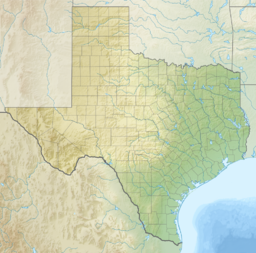|
Lake Whitney (Texas)
Lake Whitney is a flood control reservoir on the main stem of the Brazos River in Texas. It is located on River Mile Marker 442 and controls drainage for 17,656 square miles (45,730 km2) of Texas and parts of New Mexico. The reservoir encompasses a surface area of more than 23,500 acres and 225 miles (362 km) of shoreline. The area consists of rolling, tallgrass prairies; cedar trees; hardwood timber; and 100 ft (30 m) bluffs and rock points. Lake Whitney is also part of the Texas Lakes Trail Region of North Texas. Whitney Dam is a concrete gravity and rolled-earth dam, 166 feet high, owned and operated by the United States Army Corps of Engineers. HistoryBefore the presence of the lake, the Brazos River Valley provided a hospitable landscape for human occupation for centuries. Archeologists have unearthed prehistoric sites dating back to well over 12,000 years ago.[1][2] Throughout the early 1800s, Commanche, Taovaya, Caddo, and Hainai peoples settled along banks of the Brazos in this area. The most prominent group, the Hainai, migrated from Louisiana in 1835. Anglo-American traders and soldiers referred to their settlement as Towash Village, for the name of the Hainai's chief. The arrival of substantial numbers of Anglo-American settlers in 1850 displaced the Hainai's village and were forced to move further upstream. The White pioneers apparently established a settlement, which they called Towash, at the site of the former Native American community.[3][2] Texas experienced a number of devastating floods in 1913 and 1921 resulting in death and destruction due to rivers overflowing from heavy rainfalls.[4] As a result, in the 1930s the US government began approving and authorizing the building of dams along Texas rivers with the intention to absorb these floodwaters. The plan to create the Whitney Reservoir on the Brazos River for flood control and other purposes, such as hydro-electric power development, was originally approved and authorized by Congress in 1941. However, when the US became involved in World War II, the funding was diverted to the war effort. Construction of the dam resumed in the Flood Control Act of 1944.[5] The construction of the dam started in May 1947 and the Brazos River was impounded in December 1951. The construction of the dam's powerhouse began in April 1951 and was completed in June 1953.[5] After a record-breaking drought in Texas during the 1950s, there was an emphasis on reservoirs serving a secondary purpose as water storage facilities for Texas residents, communities, businesses, agriculture, and others.[6] Today, the U.S. Army Corps of Engineers continues to operate several flood control reservoirs within the Brazos River basin, including Lake Whitney.[7] FishingLake Whitney offers a wide variety of freshwater fish. Predominant fish species consists of the following:
The Texas Parks and Wildlife departments advises anglers check bloom status for golden algae as it is toxic to the fish and will impact fishing practices.[8][9] Recreation Lake Whitney is a year-round destination for Texas residents due to the abundance of water sports and activities all ages can enjoy and its proximity to Dallas-Fort Worth along the Interstate 35 Corridor. The most popular activities at the lake include fishing, boating, sailing, jet skiing, wakeboarding, water skiing, hunting, and golf. The area was designated as the Getaway Capital of Texas by the Texas Legislature in 2005.[10] In 2011, this designation was reconfirmed by the Regular Session of the 82nd Legislature in House Concurrent Resolution No. 83. This declaration reads as follows:[11]
External linksReferences
External linksWikimedia Commons has media related to Lake Whitney.
|
||||||||||||||||||||||||


